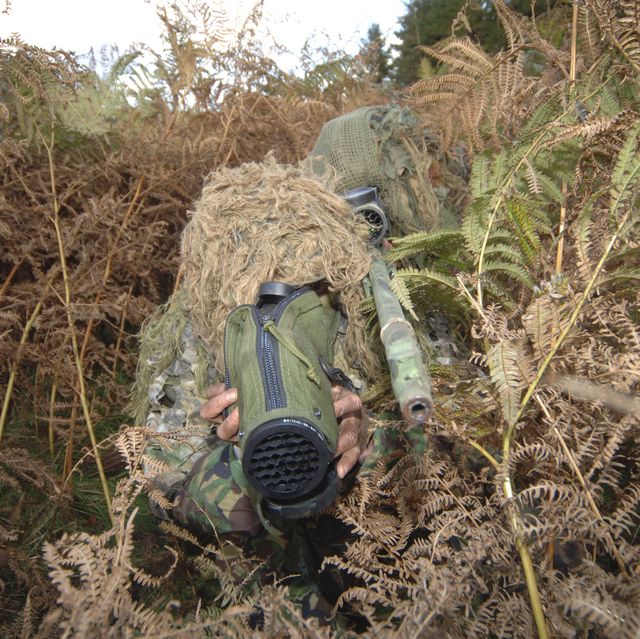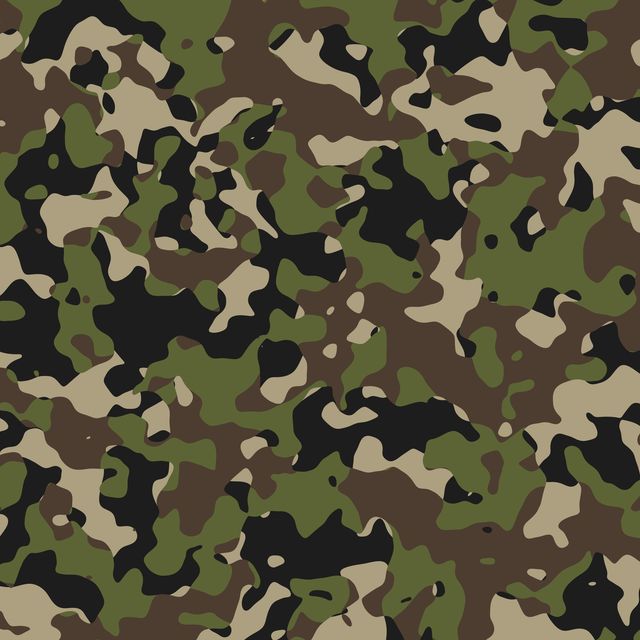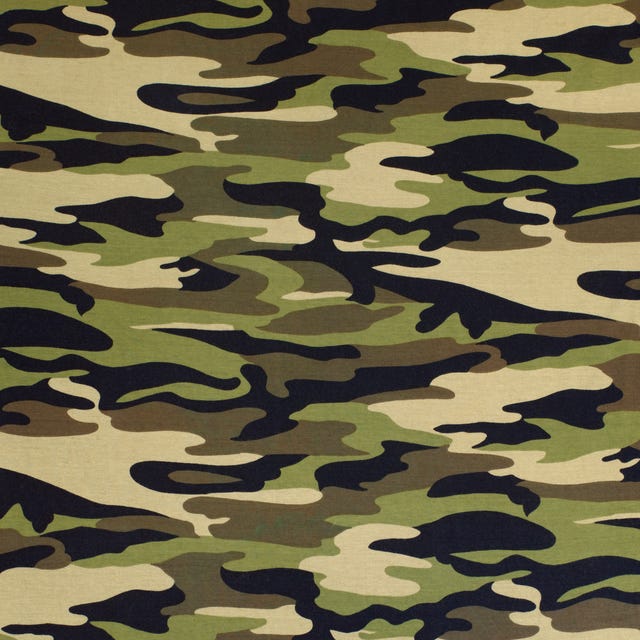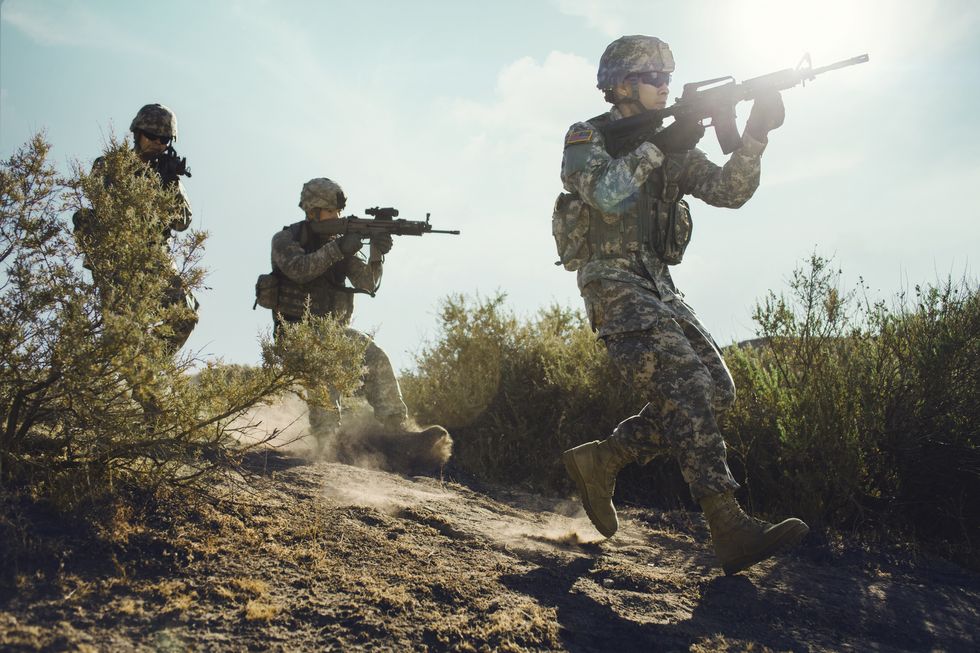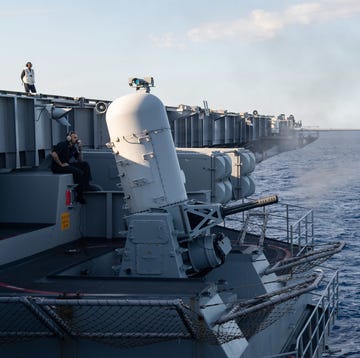Humans aren’t great at blending in with their environment. In the 20th century—after we ditched the rather barbaric style of fighting wars in fields, with line formations charging at one another—camouflage would become a vital tool. This has grown into a multi-billion-dollar industry meant to keep soldiers hidden on the battlefield, offering a significant tactical advantage.
Here’s everything you need to know about U.S. military camouflage systems, as well as the camouflage techniques taught from basic training all the way up to the advanced U.S. Army Sniper Course.
What Is Camouflage?
Camouflage is a technique that involves the use of color, texture, and illumination to blend in with the surrounding environment. “It’s any type of pattern that will help make you indiscernible or blend into nature … rather than trying to look like a bush or look like a tree, you’re just simply trying to look like nothing,” Staff Sgt. Michael Biza, a U.S. Army Sniper Course instructor with the 316th Cavalry Brigade, tells Popular Mechanics.
It’s a much more three-dimensional concept than just patterns on combat uniforms or snipers in ghillie suits. For instance, cover and concealment are obvious camouflage considerations, but there’s more to them than meets the eye.
We can separate camouflage techniques into three different pillars: visual, movement, and sound.
Visual
Camouflage may seem like a merely visual process. And that’s a fundamental part of it, but there’s so much more complexity as you get into it. When learning about camouflage, target detection is one of the major building blocks, and it involves finding anomalies in your environment.
“In a wooded environment, you’re gonna see different types of coniferous trees ... you’ll see leafy bushes, some grass, stuff like that,” Biza says. These red herrings can be as simple as a tree that’s been snapped, or missing bark—and often telegraph your position. “If you see something out of the ordinary, you’re burning in on that area … looking for further abnormalities.”
While this is more offense over defense, it’s valuable knowledge when moving under the radar. Camouflage is all about eliminating depth between yourself and everything that’s behind you. At the most basic level, this can be done with camouflage patterns printed onto combat uniforms. The current U.S. Army combat uniform uses a pattern called Scorpion—officially known as the Operational Camouflage Pattern (OCP). This mix of colors has proved to provide adequate concealment for our infantry since 2015.
Camouflage patterns can be broken into three different categories: striping, blotching, and a combination of the two. Stripes excel in coniferous environments, which include forests that mostly consist of, well, conifers—types of trees that grow needles instead of leaves, like pines. Blotches excel in more deciduous environments, which are effectively the opposite of coniferous environments; deciduous forests include trees that grow leaves instead of needles. These trees also lose their leaves in the winter, which brings substantial changes as the seasons come and go. The U.S. military uses a combination of the two, which is designed to excel in both environments. Check out the gallery below to spot the differences between these types of camouflage.
Face paint is a big helper in camouflaging the human silhouette. “Typically, you’re trying to bring the natural curvature of the face onto one plane,” Biza says. This fulfills the golden rule of camouflage, which is taking away depth. Once you break out the paint kit, the first step is darkening the high points of your face—think of your cheeks, nose, and brow ridge. Then lighten up any indentations like your lips, eyes (eyelids), ears, and any other areas to eliminate shadows. Note that you’ll need to reapply face paint in hot or wet conditions when the paint tends to run.
Patterned uniforms and face paint can be effective, but they’ll never be able to match the level of concealment that a ghillie suit provides. “Ghillie suits are one of our more important tools … it helps break up that natural, just hard outline of a human silhouette,” Biza says. Outside of breaking up the silhouette, the ghillie suit is undoubtedly more effective than a camouflage uniform at eliminating depth.
Ghillied-up snipers often look like brush and other ground cover when they’re out of concealment. Skeins are the material on the suit that create this type of look, and have evolved quite considerably over time. Earlier models would be built from the ground up, tying strips of burlap through a net. However, the latest Improved Ghillie System (IGS) uses lighter and more breathable materials that are also less flammable.
Movement
Even with the best hide site in the world, movement can still telegraph your position. Navigating terrain without being detected will always be a component of combat: get in, do what you need to do, and get out. However, every step needs to be carefully calculated.
This is where the sniper walk comes in, one of the first techniques that Sniper Course students learn in training because it allows you to cover a fair amount of ground without being detected. There are five movement techniques—including the sniper walk—that teach everything from a low crawl all the way up to a standing patrol walk. (See below.)
These movement techniques all rely on how much concealment is available in your environment and how fast you need to move through it. That being said, moving efficiently without being detected not only involves visual detection but also involves minimizing your sound signature.
Sound
Something as small as a twig snap can give away your position. “Anything that can make noise, whether it’s your equipment, your ghillie suit, or yourself, you’re doing everything you can to silence that,” Biza says.
Along with silencing your equipment, there are a number of ways to minimize your sound signature while moving. Biza tells us that foot placement is a critical component of the sniper walk; specifically, walking heel to toe allows you to be very slow, deliberate, and quiet. The sniper walk also allows you to distribute your weight more easily, which can be critical as twigs and other noisy obstacles can sometimes be unavoidable.
Next time you’re hiking through the woods, take note of how much noise you make—you might be surprised how loud your footsteps can be.
Matt Crisara is a native Austinite who has an unbridled passion for cars and motorsports, both foreign and domestic. He was previously a contributing writer for Motor1 following internships at Circuit Of The Americas F1 Track and Speed City, an Austin radio broadcaster focused on the world of motor racing. He earned a bachelor’s degree from the University of Arizona School of Journalism, where he raced mountain bikes with the University Club Team. When he isn’t working, he enjoys sim-racing, FPV drones, and the great outdoors.
